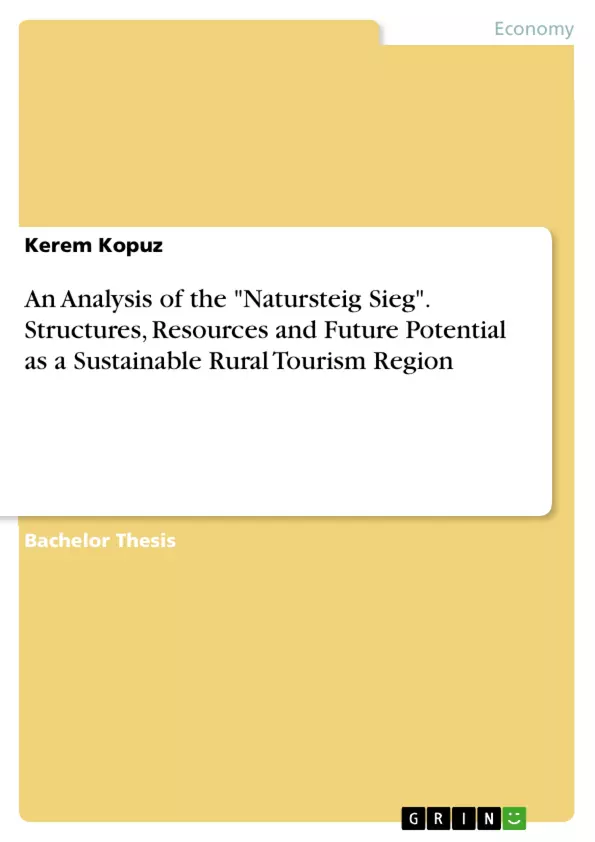The analysis of the structures, resources and future potential of the "Natursteig Sieg", a rural region in North-Rhine- Westphalia, is the aim of this thesis.
Today’s tourism industry can be considered as an economically important asset. Particularly in rather structurally weak rural areas, tourism can significantly contribute to secure employment and to generate beneficial income. Rural regions in Germany have a high touristic potential. A tourists increasing demand to relax within a natural environment, away from urbanized areas, offers versatile possibilities to sustainably develop rural tourism.
The focus is laid on future perspectives and sustainable development, which is extensively investigated with the help of academic frameworks. The main research was conducted in form of qualitative expert interviews with 7 respective industry stakeholders and participating project partners of the "Natursteig Sieg".
It is found that there are several strategic management issues in terms of communication, transparency and marketing which can and should be solved in the long run, in order to guarantee an effective course of action. However, the region as such has indeed a high future potential of being a successful, economically valuable and sustainable rural tourism destination.
Inhaltsverzeichnis (Table of Contents)
- 1. Introduction
- 1.1 Motivational Background
- 1.2 Research Objectives
- 1.3 Thesis Structure
- 2. Literature Review
- 2.1 Introduction
- 2.2 Definition of Rural Tourism
- 2.3 Rural Tourism Destinations
- 2.4 Destination Strategies in Rural Areas
- 2.5 Measures and Evaluation of Competitiveness
- 2.6 Sustainability in Rural Tourism
- 2.7 Summary and Future Perspectives of Rural Tourism
- 3. Methodology
- 3.1 Methodology
- 3.2 Methods
- 4. Findings and Analysis
- 4.1 Research findings
- 4.2 Previous research
- 4.3 Stakeholders of the Natursteig Sieg
- 4.4 Rural tourism strategies and cooperation
- 4.5 Sustainability and competitiveness
- 4.6 Future Perspectives and Potential
- 5. Conclusion
Zielsetzung und Themenschwerpunkte (Objectives and Key Themes)
This thesis aims to analyze the future potential of the ‘Natursteig Sieg’, a rural region in North-Rhine-Westphalia, as a sustainable tourism destination. It investigates the region's strengths, weaknesses, and opportunities through qualitative expert interviews with key stakeholders.
- The definition and characteristics of rural tourism.
- Strategic management issues and challenges in rural tourism.
- The role of stakeholders in shaping rural tourism development.
- The importance of sustainability and competitiveness in rural tourism.
- The potential for future development and growth of the ‘Natursteig Sieg’ as a rural tourism destination.
Zusammenfassung der Kapitel (Chapter Summaries)
The introduction provides an overview of the research topic, the research objectives, and the structure of the thesis. Chapter two presents a comprehensive literature review on rural tourism, discussing its definition, structures, strategies, sustainability, competitiveness, and future perspectives.
Chapter three focuses on the methodology used in the research, including the justification of the chosen method, the selection of interview partners, and the development of the interview questions. Chapter four presents the primary research findings based on the expert interviews, analyzing key stakeholder perspectives on the ‘Natursteig Sieg’ and its potential as a rural tourism destination.
Schlüsselwörter (Keywords)
The key focus of this thesis lies on rural tourism, sustainable development, stakeholder engagement, and the potential of the ‘Natursteig Sieg’ as a successful rural tourism destination. It explores relevant aspects of destination management, regional competitiveness, and the importance of strategic planning for long-term success.
- Quote paper
- Kerem Kopuz (Author), 2013, An Analysis of the "Natursteig Sieg". Structures, Resources and Future Potential as a Sustainable Rural Tourism Region, Munich, GRIN Verlag, https://www.grin.com/document/500107



